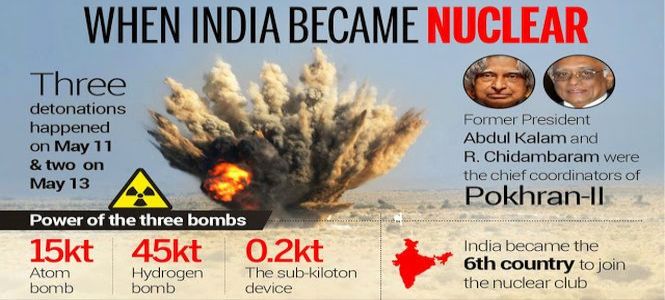Pokhran-II: A Moment Of Profound Epiphany
Context:
On May 11 and 13, 1998, India tested five nuclear weapons with cutting-edge designs at the Pokhran range in the Rajasthan Desert.
Pokhran-II
- Five nuclear bomb tests were conducted at the Pokhran Test Range of the Indian Army in May 1998.
- Five bombs were detonated during Pokhran-II, the first of which was a fusion bomb and the other four were fission bombs.
- The first three explosions happened at the same time on May 11 at 15:45 IST. These included a 0.2 kt sub-kiloton (i.e. less than 1 kiloton) bomb, a 15 kt fission device, and a 45 kt thermonuclear device. The two nuclear explosions that occurred simultaneously on May 13 each had sub-kiloton yields of 0.5 and 0.3 kt.
- The Comprehensive Test Ban Treaty (CTBT) discussions began in the 1990s. It was a challenging position. The CTBT would permanently end our ability to use nuclear weapons if India joined.
- It would be required to provide a clear justification for its refusal to sign if it did so.
- And India had to choose because the deadline was coming up in May.

Need Of The Hour
- The Nuclear Non-Proliferation Treaty (NPT) served as the cornerstone of the post-second world war system for global nuclear control, which included the P-5 and other nations. India was not particularly pleased with this biassed world, although being completely committed to the peaceful applications of atomic energy.
- China openly declared itself to be a nuclear state and we have lost to China in the Indo-China War. Although things have improved since then, there was still a mistrustful atmosphere at the time. Pokhran-II was required to secure India’s borders and increase our nation’s chances of winning any future wars.
- China has additionally aided Pakistan with its pursuit of nuclear weapons. Additionally, Pakistan has previously committed three acts of aggression. India needed to develop nuclear capability despite economic sanctions in light of this.
Points to Ponder
- India conducted nuclear tests at Pokhran on May 11 and 13, 1998, which removed the mystery around its nuclear project and policies.
- India’s choice to carry out the tests had a significant effect on its standing, security, and capacity to shape the global order.
- The tests sparked a chain of events that included American sanctions, Pakistani nuclear testing, and criticism from China, Congress, and the Left in India.
- However, three misconceptions were refuted by India’s nuclearization and the following events:
- the idea that a BJP government decided to conduct the exam without consulting the general populace. Since India’s independence, nearly every Prime Minister has been “implicated” with the country’s nuclear weapons programmes.
- the idea that India will suffer from isolation and economic collapse as a result of sanctions and worldwide condemnation. The India-US Civil Nuclear Agreement, which was finalised in 2005, was the result of the US mainstreaming India as a unique circumstance.
- The notion that deterrence theory could not be applied to South Asia and India because they could not be “trusted” with nuclear weapons. India has much more advanced security procedures in place than the United States and the Soviet Union had 25 years after acquiring nuclear weapons.
- The article honours the wit and cunning of India’s political and scientific leaders, who refused to give in to pressure and overcame great obstacles to construct a reliable nuclear deterrent.
- According to the report, India’s nuclear tests were a reflection of a deep revelation that saw India reawaken to its potential and gain confidence in itself.
Similar Topics





